Setting
The series is largely set on a fictional planet named Well World. The Well World was constructed by an ancient alien species, known as the Markovians, who felt they had reached a dead end in their evolution. The Well World houses a planet-sized, reality-shaping computer that creates an artificial universe layered on top of the much smaller, original Markovian one. The Well World exists within the original Markovian universe, and can only be accessed through gateways on a number of Markovian planets scattered through the artificial universe. The Markovians experimented in species design on the Well World, sending the more successful ones into the new universe to populate one of these planets. By the time of the stories in the series, the Markovians have vanished, leaving behind the Well World, continually maintaining the new universe.
The Well World's surface is composed primarily of 1560 large hexagonal regions—called "hexes"—each with an independent and often dramatically different climate and ecosystem, that David Langford compares to the hexagonally tiled boards used in "hex-and-counter" forms of tabletop wargaming. Each of these hexes is a prototype environment for a planet that exists in the external universe, half of which, comprising the planet's southern hemisphere, contain carbon-based (or similar) oxygen-breathing life. The North is made up of exotic species which are often so alien that no common ground exists between them and the Southern races, and, often, their Northern neighbors as well. Since the Northern hemisphere contains, for example, seas of oxygen, chlorine, methane, and ammonia, Southern races need some kind of life support in the North. The two hemispheres are separated by an impermeable wall that extends "several kilometers upward". In the hexes that are bisected by the wall there is a separate gateway (the "avenue") to the Well of Souls, the control center for the computer.
The Well World computer also maintains a "tech level" for each of the hexes, making equipment of a higher level simply fail to work. High-tech hexes work as in the "real" universe, allowing any device to work. Semi-tech hexes allow simple machines to work, up to about the level of the steam engine, and any device using electricity will not work. Low-tech hexes allow no machines to work, and all effort has to be created by muscles. Even then, there are exceptions; Gedamondas is low-tech, but the Gedamondans can use naturally occurring steam from their volcanic vents, and the Agitar can electrocute people in any hex, regardless of tech level. Also, while chemical firearms do not, as a general rule, work in nontech hexes, matches and certain kinds of chemical explosives will, although the explosives can be dangerously unstable in nontech hexes. In some of the hexes, however, the Well World computer allows the inhabitants access to limited manipulation of reality, or "magic" (this is most commonly in low- and semi-tech hexes, but high-tech magic hexes have been mentioned). Vehicles that travel from hex to hex need to be equipped with multiple forms of power.
In addition to the hexes, the two polar regions, or "zones" contain maintenance areas, including a series of ambassadorial offices. These can be reached via gateways near the centers of each of the hexes, allowing easy transit from hex to pole for meetings and other duties. Newcomers to the Well World find themselves in the zones, where they are greeted by one of the ambassadors and then sent through a gateway. During this initial transit, the Well World computer transforms the traveler into a member of one of the many races, and sends them on to the associated hexes. From that point, the traveler is treated as a native of that hex. Since the only way to enter/leave Zone is through a Zone Gate, and exiting through any Zone Gate always takes one to their home hex, it is generally impossible for Southern and Northern races to travel into the other hemisphere. An InterZone Gate allows Northern and Southern ambassadors to travel between opposite Zones, and most materials can be transported via Zone gates, so there is some limited trade between North and South; for example, "universal translators" are grown in a Northern hex, and allow almost all races to communicate, at least within the limits of common ground. A very few instances of travel from North to South (or vice versa) have occurred, but these were exceptional.
The Equatorial Barrier contains six "Avenues" on either side of the barrier; each avenue leads up to the naked barrier. These are the only authorized entry points to the Well of Souls computer which controls and regulates the entire universe. The main control room contains what appears to be a crystal model of the Well World, but is, in fact, a separate control computer which regulates and stabilizes the Well World itself. This allows the main computer to be shut down and restarted without destroying the Well World. Any person who carries the "Original" pattern is converted into "Markovian" (also "Ancient", "Creator", or "Maker") form to solve design problems, as only this form possesses the capacity, knowledge, and capabilities necessary to interface with the main Brain. Also, any such personnel are recognized during Well processing, and treated as individuals of the race from which they originated. For this reason, Nathan Brazil (and, later, Mavra Chang) is translated to Glathrial, the home of type 41 (humans), without even being normalized to the Well-specific form.
In addition to the Well World, some of the action in the stories, typically the introductions, takes place in the multi-stellar human empire. In the early books this largely controlled by the Community of Worlds (the "Com"), where genetically engineered clones are widely used to form peaceful communist societies. In later books the Community has been replaced by the Realm, a confederation of over forty races. In the Watchers at the Well trilogy, the action starts on contemporary Earth long after the reset of the Well Computer.
Analysis
Writer Max P. Belin observes that as a plot device, the Well World has its advantages and disadvantages. It enables the protagonists of the stories to travel "across mountains, grasslands, oceans, deserts, and forests" without the use of any magical means for moving from world to world (such as those in C. S. Lewis's The Magician's Nephew (1955), which would be outside the domain of a science fiction story) or inexplicable "hypertechnology". Rather, they travel under their own power from hex to hex. (With many hexes, it is possible to travel from one border to another in a matter of days, or sometimes weeks.) Since each hex not only has different environments and species—ranging from conventional classical mythological species such as yeti, centaurs, and satyrs to more esoteric science fiction species such as giant carnivorous insects and mobile plants—but as well a different, fixed, level of allowable technology—from non-tech and semi-tech hexes through to highly advanced technology that closely resembles outright magic (plus actual Well magic)—and since there are 1,560 of them, the author never need repeat situations and locations through the entire series of books.
The Well World also introduces extra plot elements. Since every person apart from Nathan Brazil, a major protagonist of several of the stories, is transformed into one of the Well World's own 1,560 species by the act of passing through the gateway on a Markovian world to the Well World, they have to cope with travelling companions who used to be human but no longer are, and all of the ensuing problems.
The Well World forces the introduction of two additional plot elements into every story. Since the only routes to the Well World from the outside are the gateways on the now-deserted and forgotten Markovian planets, every story has to incorporate their rediscovery in some fashion. Similarly, since there is no normal way off the Well World's surface from the hexes to either the original Markovian or the new artificial universe, every story has to incorporate an "escape from an escape-proof laboratory" of some kind for the characters to interact with the external universe. Furthermore, the nature of the Well World as a set of laboratory environments, whose technology levels and ecosystems are forcibly computer-controlled, limits what can potentially occur therein.
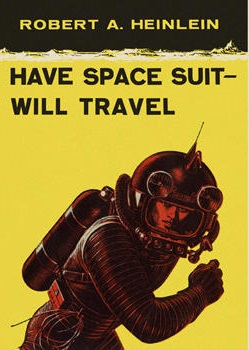
Have Space Suit—Will Travel is a science fiction novel for young readers by American writer Robert A. Heinlein, originally serialized in The Magazine of Fantasy & Science Fiction and published by Scribner's in hardcover in 1958. The last Heinlein novel to be published by Scribner's, it was nominated for a Hugo Award in 1959 and won the Sequoyah Children's Book Award for 1961. Heinlein's engineering expertise enabled him to add realistic detail; during World War II, he had been a civilian aeronautics engineer at a laboratory which developed pressure suits for use at high altitudes.

Strata is a 1981 science fiction comedy novel by Terry Pratchett. It is one of Pratchett's first novels and one of the few purely science fiction novels he wrote, along with The Dark Side of the Sun.
Christie Golden is an American author. She has written many novels and several short stories in fantasy, horror and science fiction.

Manifold: Time is a 1999 science fiction novel by Stephen Baxter. It is the first of Baxter's Manifold Trilogy, although the books can be read in any order because the series takes place in a multiverse.
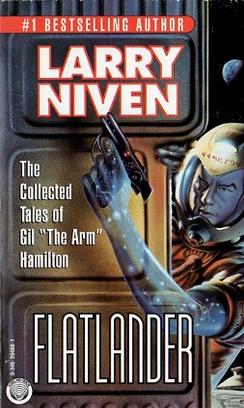
Flatlander (ISBN 0-345-39480-1) is a 1995 collection of stories by American writer Larry Niven, all set in Known Space. It is the definitive collection of all stories by Niven about ARM agent Gil Hamilton. Many of the stories revolve around the theme of involuntary organ transplantation.

Halo: Ghosts of Onyx is a military science fiction novel by Eric Nylund, based on the Halo series of video games. The book was released in October 2006 and is the fourth Halo novel; Nylund's third contribution to the series. Onyx was also the first of three Halo novels to be published by Tor Books, rather than the previous publisher, Del Rey.

The Giants series is a group of five science fiction novels by James P. Hogan, beginning with his first novel Inherit the Stars (1977). The series tells the discovery humans did not originate on Earth, but from an ancient civilization that developed elsewhere in the solar system.
The Four Lords of the Diamond is a series of four science fiction novels by author Jack L. Chalker. Each volume of the series primarily follows a duplicate of a government agent as he lands on his prison planet and begins to both investigate the menace to the civilized worlds and find his position in his new society. The duplicates realize the stagnancy and corruption of the Confederacy, the intergalactic government in the series, and question their position as tools of the hierarchy. As the series progresses, the primary agent experiences each of his counterparts' divergent experiences and begins to question his beliefs as well. Like much of Chalker's work, the series deals with the effects physical transformations have on a character's personality.

Space Empires IV is a turn-based 4X strategy computer game developed by Malfador Machinations and published by Strategy First as part of the Space Empires series in which players control an alien race in an attempt at galactic conquest.
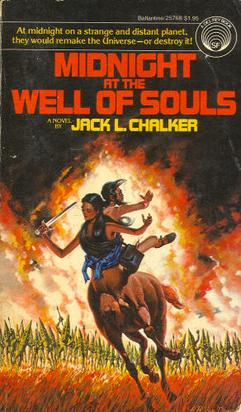
Midnight at the Well of Souls is the first book in the Well of Souls series by American author Jack L. Chalker, first published as a paperback in 1977. Over a million copies of the original printing were sold, and reprints have continued for decades. It came in #18 in the 1978 Locus Poll Award for best science fiction.

Exiles at the Well of Souls is the second book in the Well of Souls series by American author Jack L. Chalker. Originally intended to be one book, the story was split into Exiles and Quest for the Well of Souls forming a duology.

Quest for the Well of Souls is the third book in the Well of Souls series by the American author Jack L. Chalker, and completes the Wars of the Well World duology begun with Exiles at the Well of Souls. A foreword by Chalker indicates that Quest and Exiles were originally conceived as a single book, but due to the decision to split them, Quest was written to be readable as a standalone novel.
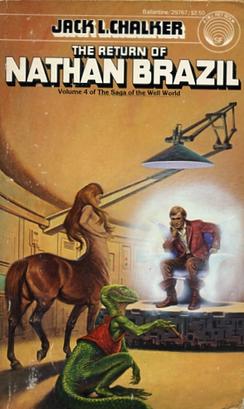
The Return of Nathan Brazil is the fourth book in the Well of Souls series by American author Jack L. Chalker.
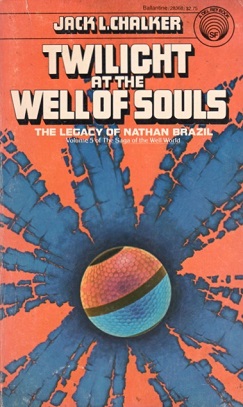
Twilight at the Well of Souls is the fifth novel in the Well of Souls series of science fiction novels by American author Jack L. Chalker. It concludes the narrative begun in the fourth book, The Return of Nathan Brazil.

Quex-Ul is a supervillain appearing in American comic books published by DC Comics. He is depicted as an enemy of Superman, although they are also sometimes allies.

This is a bibliography of works by writer Peter David.

The space-opera blockbuster, Star Wars franchise has borrowed many real-life scientific and technological concepts in its settings. In turn, Star Wars has depicted, inspired, and influenced several futuristic technologies, some of which are in existence and others under development. In the introduction of the Return of the Jedi novelization, George Lucas wrote: "Star Wars is also very much concerned with the tension between humanity and technology, an issue which, for me, dates back even to my first films. In Jedi, the theme remains the same, as the simplest of natural forces brought down the seemingly invincible weapons of the evil Empire."

Midnight at the Well of Souls Role-Playing System is a science fiction role-playing game published by TAG Industries in 1985 that is based on the "Well of Souls" novels by Jack L. Chalker.
Bibliography of science fiction and fantasy writer Jack L. Chalker:
















